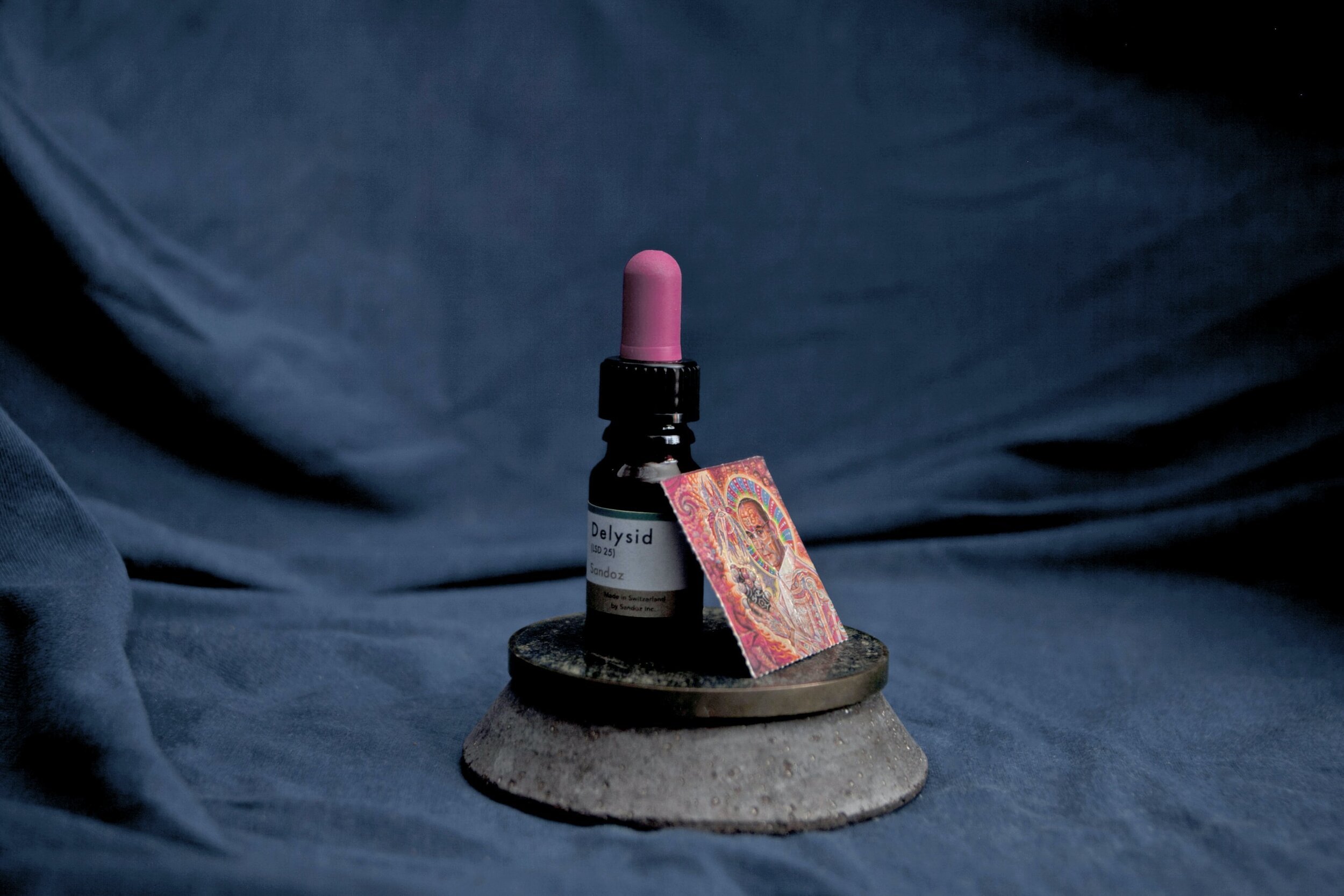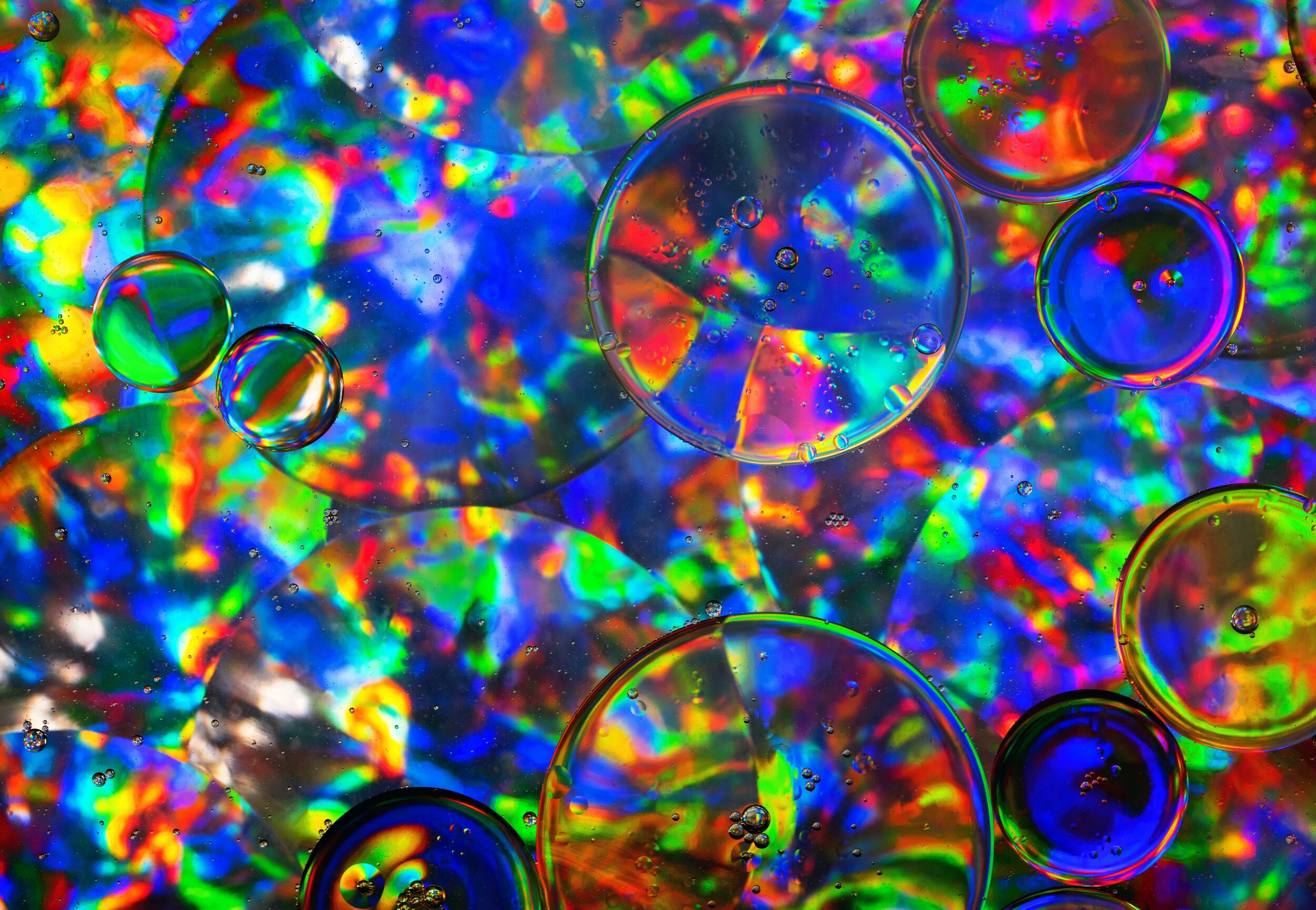
LSD
St. Albert and the LSD Revelation Revolution - Alex Grey
Commonly referred to as “acid”, Lysergic Acid Diethylamine (LSD), is a psychedelic drug based on the chemical structure of ergot fungus, which was first synthesized by Swiss chemist Albert Hoffman in 1938.
LSD is typically sold either in liquid or as tabs, which are small pieces of paper that have been soaked in the liquid and are placed under the tongue for absorption.
LSD is a classical psychedelic drug and its effects include visual hallucinations, intensified sensations, and distortions of time and space.
Effects
Potential positive effects include enhanced empathy, increased openness, increased well-being, increased emotional excitedness, enhanced analysis, increased appreciation of music, increased libido, ego suppression, increased sense of humour and laughter and enhanced creativity. (https://www.ncbi.nlm.nih.gov/pmc/articles/PMC5026740/)(Psychonaut Wiki)
Potential neutral effects include increased dreaminess, time distortion, enhanced colour vision and visual acuity, visual distortion, visual hallucination (including geometry, after images, depth perception changes and morphing images), synaesthesia and spontaneous body sensations. (https://www.ncbi.nlm.nih.gov/pmc/articles/PMC5026740/)(Psychonaut Wiki)
Potential negative effects include increased cognitive disorganisation, increased delusional thinking, increase in paranoia, increased mania, increased suggestibility, and difficulty urinating. (https://pubmed.ncbi.nlm.nih.gov/26847689/)(https://pubmed.ncbi.nlm.nih.gov/25242255/)
A person may experience physical effects that include increased blood pressure, increased heart rate, increased body temperature, increased in pupil size, excessive yawning, appetite suppression, nausea, increased sweating and dehydration. (https://pubmed.ncbi.nlm.nih.gov/26847689/)(Psychonaut Wiki)
Dosage
10-75 ug: Microdose to mild dose - At this dosage range, people can experience mild alterations in mood and subtle feelings of euphoria. People may still have visual hallucinations, but these are less profound than higher doses. People may have increased clarity and colour vision, and objects may appear to be “breathing” and “morphing”. At the lower end of this dose range, people may experience increased creativity and focus, see more under microdosing guidance
75-150 ug: Low to moderate dose - At the lower end of this dosage range, people may experience visual hallucinations which are limited to increased colour vision and “breathing” objects, however, when the dosage is increased to around 150 ug people’s visual hallucinations become more profound, and objects become may more distorted and moving.
150-300 ug: Moderate to high dose - People may find this dose very intense during the “peak” (the point where effects are most strongly felt). People may experience intense visual hallucinations and closed eye visuals at this dose. There is a potential for thought looping patterns to occur and panic to arise in these higher dose ranges. People taking these high doses may experience strong feelings of connectedness and intense waves of emotion, including extreme happiness and laughter. People may potentially also have profound realisations at these dosages.
300+: Very strong dose - People are most likely to experience very intense visuals at this dose range which may be overwhelming if they don’t expect it. People may experience distortions in their logical thinking and perception of time and depth perception. People may also experience body experiences, dissolution of ego and a sense of oneness with the outside world may arise. Mystical experiences reported at these doses.
Duration
Onset: 30-90 minutes
Duration: 9-14 hours
After effects: Up to 24 hours
Dangers
What not to mix with:
Drugs that lower seizure threshold: Some evidence suggests psychedelics could increase the risk of seizures, especially for those with a personal or family history of epilepsy. Using psychedelics alongside other drugs that may also increase the risk for seizure, such as tramadol, could further increase this risk. You can learn more about medications associated with increased seizure risk here.
MDMA: LSD effects can be increased MDMA, so when taking the drugs together, the doses mean the effects of either drug can be stronger than expected. LSD can also enhance MDMAs toxic effects. (https://onlinelibrary.wiley.com/doi/abs/10.1002/nrc.20023)
Antidepressants: There is little known about the combination between antidepressants and LSD. However, in one case report, a 47-year-old male began experiencing LSD flashbacks after beginning a course of SSRI antidepressants. The case authors explained this effect likely occurred because of the sudden increase in serotonin following antidepressants. You can learn more about the combination of classic psychedelics and antidepressants under our general psychedelic risks and harm-reduction section of our website.
In some instances, antidepressants blunt or even prevent psychedelic experiences.
In one case report, a 47-year old male began experiencing LSD flashbacks after beginning a course of SSRI antidepressants.
You can learn more about the combination between classic psychedelics and antidepressants under our general psychedelic risks and harm-reduction section of our website.Stimulants: Mixing stimulants, such as amphetamines and cocaine, with LSD can increase anxiety levels and the risk of thought loops. As both LSD and stimulants increased heart rate and blood pressure, this could potentially put extra pressure on the cardiovascular system, which can increase the risk of dangerous outcomes, including heart attack. (https://onlinelibrary.wiley.com/doi/abs/10.1002/nrc.20023)
Cannabis: Cannabis and LSD increase the effects of one another, so taking together can lead to unpredictable outcomes. Smoking cannabis may bring about visual hallucinations once they have ended, which can be unpleasant when unplanned.
What are the dangers?
Fatality: There is no known lethal dosage of LSD. However, when "bought on the street", LSD may be mis-sold with drugs that are similar to LSD but have a higher potency and are potentially toxic, such as NBOMe and NBOMe analogues (read more about NBOMe).
Experiencing a psychedelic crisis, risk of psychosis and Hallucinogenic Perception Persisting Disorder: General risks for all psychedelics apply. Read more under our general psychedelic risks and harm-reduction section of our website.
Serotonin Syndrome: Consuming stimulants or drugs which act on the serotonin system, together with LSD, increases the risk of serotonin syndrome. Read more under our general psychedelic risks and harm-reduction section of our website.
Difficulty “landing”: After experiencing profound changes in one’s sense of reality, it can sometimes be difficult to return to everyday life. Challenging experiences and being unable to understand or express the experience can leave people feeling isolated, confused, and distressed. Working with an integration coach or attending an integration circle can help people to make sense of their experience and ground back into everyday life.
Cardiac problems: Classical psychedelics have a stimulating effect, meaning they can increase heart rate and blood pressure. In clinical trials, these effects tend to be mild, and often reported as non-clinically concerning.
However, two case reports have described cardiac arrest following both LSD and psilocybin. In both cases, the users were suspected to or confirmed to have underlying health complications and may have been using other drugs. These reports suggest psychedelics, especially when combined with other stimulant drugs, could increase pressure on the heart to dangerously high levels, especially for those with pre-existing health conditions.
In clinical research, participants with cardiovascular diseases are often excluded from psychedelic trials because of this risk.
How can the risks be minimised?
To decrease the risk of death resulting from impurities (drugs being mis-sold as LSD or added to LSD), try and be sure the drug that is being taken is pure. If you have access to drugs-testing kits, then testing the drug before taking any is strongly recommended. If any concerning physiological symptoms (such as tremors or an excessively high heart rate) arise during the trip, then ensure an ambulance is contacted.
Having the correct set and setting will likely decrease the risk of a psychedelic crisis, read more under general psychedelic risks and harm-reduction advice.
By being in a safe environment with a trusted trip sitter present, this can help reduce the risk of adverse outcomes caused by impulsive decision-making and behaviours linked to impaired judgement.
Integrating a psychedelic experience has the potential to resolve trauma relating to difficult psychedelic experiences. Integration can also people process and learn-from psychedelic experiences. To learn more about integration and integration tools and tips, you can visit the “Psychedelic Integration” section of our website.
What are the potential benefits?
Scientific research has investigated the therapeutic potential of LSD in:
Web Pages
Drugs and me includes a comprehensive drug overview including harm-reduction advice, an overview of combining LSD with various other drugs: https://www.drugsand.me/en/drugs/lsd/#Harm-Reduction
Psychonaughtwiki has a rich source of information about LSD and includes trip reports for varying doses of the drug: https://psychonautwiki.org/wiki/LSD#cite_note-30
Drug Science has a comprehensive drug overview, including LSD risks, the effects of LSD as a drug on the body and brain and debunking myths about the drug: https://drugscience.org.uk/drug-information/lsd/#226098994910504
Youtube video explaining how LSD acts as a drug in the brain: https://www.youtube.com/watch?v=LJbrLSU2Tk4&t=193s
References
https://jamanetwork.com/journals/jama/article-abstract/354885
https://pubmed.ncbi.nlm.nih.gov/16801660/
Credit to Dr Andrew Gibson for contributing his medical expertise and background in harm-reduction to the process of making this content.



